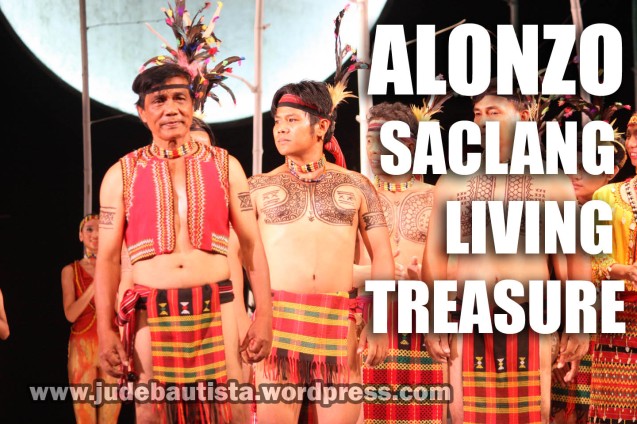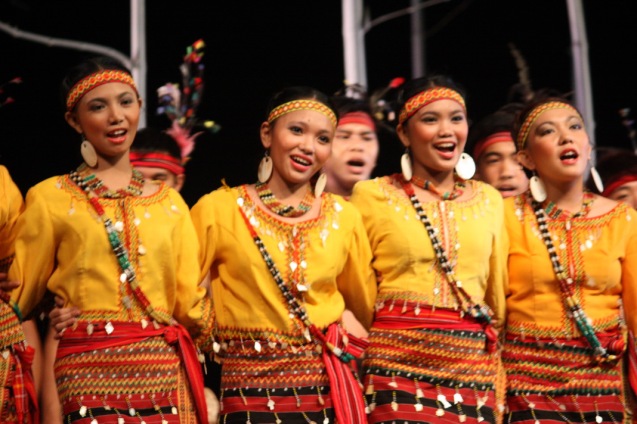[Note by Jude Bautista: Whether its music, film, literature, art, fashion, weaving etc. Filipinos have been influenced in one way or another, whether it’s the West or some Asian culture. These names and people have distinguished themselves by being keepers of TRUE 100% unadulterated Filipino art and creativity, some of them have been passed on from their forebears. Two of them sadly have passed on but true to their contribution their legacy continues, Ginaw Bilog died in 2003 while Darhata Sawabi passed on 2005.
That is why the urgency to learn and promote these true living treasures is even more crucial now. I had the privilege and honor of being able to photograph Alonzo Saclang during the Filipino Heritage festival at the Cultural Center of the Philippines last May 21, 2010. Most of the images you see in this post are from that event. The rest is from the exhibit I stumbled on to in the National Commission for Culture and the Arts (NCCA) in Intramuros. The text is also quoted directly from the exhibit for the benefit of the Filipinos and those beyond our shores. The Intramuros district is also home base to Carlos Celdran’s Walking Tours. It is no coincidence, for he too is a hero in my book.]
The list of 2010 awardees includes:
Alonzo Saclang, Federico Caballero, Haja Amina Appi, Lang Dulay, Salinta Monon, Eduardo Mutuc, Ginaw Bilog, Darhata Sawabi and Uwang Ahadas.
Directly quoted from the Exhibit:
In April 1992, The Gawad sa Manlilikha ng Bayan or the National Living Treasures Award was institutionalized through Republic Act No. 7355. Tasked with the administration and implementation of the Gawad ng Manlilikha ng Bayan is the National Commision for Culture and the Arts, the highest policy-making and coordinating body for the culture and the arts of the State. The NCCA, through the Gawad sa Manlilikha ng Bayan Committee, is mandated by the law, with support from all concerned agencies, to continue the search for the traditional artists, adopt a program that will ensure the transfer of their skills to the youth and undertake measures to promote a genuine appreciation of and instill pride among our people in the genius of the Manlilikha ng Bayan and our traditional cultures.
The artists honored in this exhibit embody the ideals established through the Gawad sa Manlilikha ng Bayan: to carry the best of our cultural heritage forward to a new generation.
Through their devotion to their art, their commitment to acquiring the necessary skills and craft, and their faithfulness to their community’s traditions, these folk artists have earned their status as National Living Treasures. The legacy they leave the next generation will live as long as their artworks exist, as long as their skills endure.
Recognizing the culture bearers with the Gawad sa Manlilikha ng Bayan encourages greater public awareness and appreciation for an aspect of Philippine culture which though endangered remains timeless and immutable.
Alonzo Saclang
Manlilikha ng Bayan
National Living Treasure
A Kalinga of Lubuagan, Kalinga Alonzo Saclang was awarded for his mastery of the Kalinga dance and the performing arts and for his persistence to create and nurture a greater consciousness and appreciation of Kalinga culture among the Kalinga themselves and beyond their borders.
Federico Caballero
Manlilikha ng Bayan
National Living Treasure
A Sulod of Calinog Iloilo, Federico Caballero was awarded for his mastery of chanting the sugidanon, the epic tradition of Central Panay and for ceaselessly working for the documentation of the epics of his people painstakingly piecing together the elements of this oral tradition nearly lost.
Haja Amina Appi
Manlilikha ng Bayan
National Living Treasure
A Sama of Ungos Matata, Tandubas, Tawi-Tawi, Haja Amina Appi was awarded for her mastery of weaving the colorful Sama mats with their complex geometric patterns that exhibit her precise sense of design, proportion and symmetry, and sensitivity to color.
Lang Dulay
Manlilikha ng Bayan
National Living Treasure
A T’boli of Lake Sebu, South Cotabato, Lang Dulay was awarded for weaving the abaca ikat cloth called t’nalak and producing creations which remain faithful to the T’boli tradition as manifested in the complexity of her design, fineness of workmanship and quality of finish.








Pingback: Tweets that mention Heroes of Filipino Culture Part 1 « Text and Photos by Jude Bautista -- Topsy.com